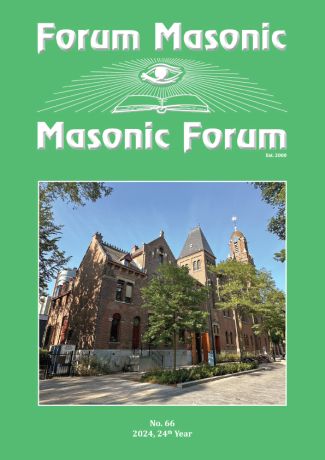John Belton, FPS
Lodge Hope of Kurrachee No. 337, Grand Lodge of Scotland
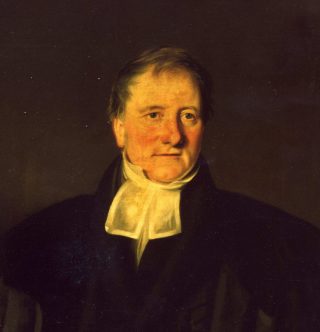
In 2008 we were all going through a giant financial crisis and, as usual, it was the greed and profligacy of bankers that was largely to blame. Bankers have often been unpopular figures over here, and recently some Scottish bankers even more unpopular. Thus it is nice to be able to tell you a tale, not about a famous man who was an indifferent Mason, but a less famous man who was a banker and really lived his principles!
If you are ever travelling to Scotland, instead of going straight up the M74 take a diversion along the A75 in the direction of Stranraer – and follow the signs to Ruthwell Cross. This monument is an eighth century Celtic cross, from a time when Ruthwell was part of Northumbria. It stood there, nearly twenty feet high, until the mid‑seventeenth century, when the post‑Reformation Idolatrous Monuments Act of 1642 eventually resulted in it being taken down. Luckily the various parts got buried and were unearthed in the early nineteenth century and put together again by the Revd Henry Duncan, the then vicar at Ruthwell.
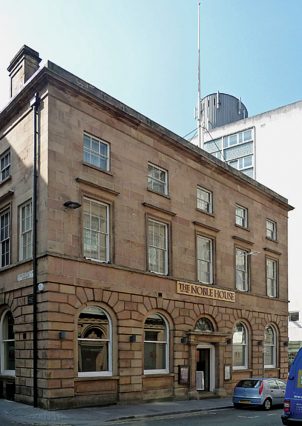
Henry Duncan was born on 8 October 1774 at the manse at Lochrutton outside Dumfries. He went to Dumfries Academy, and then to St Andrew’s University. After two terms he was tempted south to Liverpool by a family friend and took up employment at Heywood’s Bank.
After three years he returned to Scotland and to university, to take up what was virtually the family profession of the ministry. He was granted his licence to preach in 1798 and a year later was given three options – a parish in Ireland and two near Dumfries. It was Ruthwell on the Solway Coast that he finally chose.
He moved to his rural parish at a time just after a war with revolutionary France which was rapidly followed by the Napoleonic Wars. Prices had soared, wages had remained low and an agricultural worker earned maybe five (old) pence per day – all this and a series of bad harvests. Not an auspicious place to start a career one might think!
Duncan worked at trying to improve the conditions of the population of Ruthwell. He purchased flax for local spinning, bought in grain from Liverpool and reorganised what had of late been a languishing Friendly Society in the village. To further that cause, he persuaded the local landowner Lord Mansfield to give a cottage to the Friendly Society to establish its activities.
There was clearly a bond formed between Lord Mansfield and Henry Duncan, and Duncan became the family preacher when they were at home. The Mansfield dynasty was the Murray family who owned most of the land around Ruthwell, and whose second home was Scone Palace, where the Stone of Destiny once lived (until it ended up at Westminster Abbey). Some of the Murray family are buried in Ruthwell Parish Church.
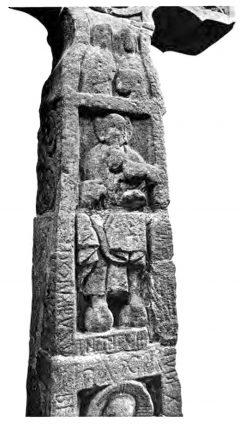
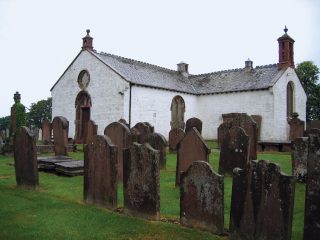
So having set the historic scene, let’s step inside the church itself. Behind the altar towers the cross itself, in a purpose‑built extension which allows it to be set two metres below the floor level. The cross is just over six metres, some twenty feet, tall. It is impressive today and one can only guess just how impressive it was some twelve centuries ago in the churchyard.
One can only gaze in wonderment at the intricate carvings of biblical scenes, Celtic knotwork patterns and, strangely, right at the centre of the arms of the cross – a triangle. Strange indeed, for having seen a few such crosses I was not aware that the triangle was a symbol normally used in eighth century carvings, but …
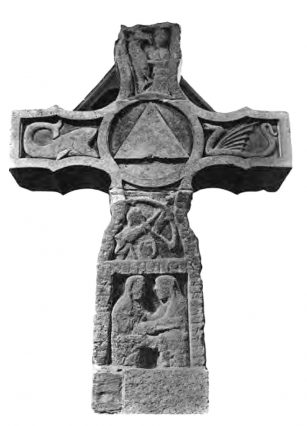
The information boards were enigmatic as to the content of the symbology on the modern (early nineteenth century) replacement of the missing cross arms, except to say that when the cross was re‑erected the Revd Duncan had a piece made to fit. Duncan being a keen Royal Arch Mason, and not knowing what was on the missing piece, simply used the triangle symbol of the Royal Arch.
Back in the car, one can set out to see the other tourist attraction near Ruthwell, the Savings Bank Museum. We had by this time got the idea that the Revd Duncan was a man of many parts. Ruthwell is literally a one‑street village: one end finishes in a field, and on either side of the street are a series of low, single‑storey Scottish cottages – one of these is the Museum.
Inside the Museum was a large replica of the cross, so we asked the Curator about the triangle and mentioned that we knew that symbol from times other than the eighth century. Whereupon he held out his hand to be shaken! So let’s look at the Revd Duncan’s big idea.
The rural poverty of the time, while locally alleviated by the Friendly Society, clearly needed a more radical approach and Duncan – maybe because of his banking experience in Liverpool, maybe because of the thrifty nature of men of the Manse, or maybe simply because saving was the thing to be encouraged as it offered some security against the unforeseen crisis – sought to find a way to offer this. In those days, to open an account at an established bank required the princely sum (then) of £10. But, as the Savings Bank website says ‘… in Ruthwell 6d (2 ½ p) was enough. The deposits were placed with the Linen Bank in Dumfries and received 5% interest. Members got 4 ½ % – on whole pounds. The surplus provided a charity fund. Tiered interest for long term savers and a sum for administering the bank’. Within five years this single simple concept, that of offering banking and savings to those of modest means, had spread throughout the UK and into Europe. In that first year the savings were £151. Ten years later in the UK that sum was over £3 million. At the millennium there were savings banks in ninety‑two countries.
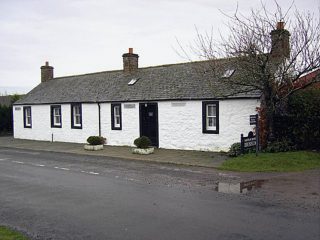
It turned out that the Revd Duncan had been a keen Royal Arch Chapter Mason and that those Chapters were all warranted from England. The situation at that time was somewhat confusing. In England Antients lodges tended to work Chapter and KT as part of the lodges’ activities (whereas the Moderns did not), and this was the practice that was traditionally followed in Scotland as well. The Minutes of what is now Thistle Lodge No. 62 in Dumfries record on 8 October 1770 the following: ‘and attest to all men enlightened that the said worshipful brother, after having been examined and found duly qualified as an Entered Apprentice, Fellow craft, Master and Mark Master Mason, was by us elected Master of the Chair, and then by us elevated to the Sublime Degree of Excellent, Super‑Excellent and Royal Arch Mason’. However, the Grand Lodge of Scotland in 1800 issued a circular ‘prohibiting and discharging its daughters to hold any meetings above the degree of Master Mason’. And at this time there was no Scottish Grand Chapter.
This left any Royal Arch Masons with a problem: now they had to seek a Warrant from somewhere! While they might by inclination have chosen the Antients, they could not help, as their lodges worked these degrees in the Craft lodges. However Lord Blaney (Grand Master of the Moderns) had set up in 1766 the Grand and Royal Chapter of the Royal Arch of Jerusalem, and it was to this that some Scottish Chapters went for their warrants.
Of the Revd Duncan’s Masonic career we know very little, not even his Craft lodge, but surely this cannot have been far from Dumfries where his family had been for three generations. We do know that at one time he was Provincial Grand Chaplain for the Province of Dumfries, and we know that his name was on an application to the Grand Chapter of Jerusalem to form a Chapter in Ruthwell. This was granted, and the RA Chapter, St John of Ruthwell No. 165, was formed in 1812. These Chapters were enough in number for there to be a First Grand Superintendent for Scotland with Cumberland and Berwick.
Henry Duncan was a man of many parts – a poet, writer of songs, and an artist. Perhaps the totality of his worth is still visible today in the form of a statue on the former Dumfries Savings Bank Building.
Before passing on to banking, it is probably only right that mention is made of Duncan’s main profession, that of being a man of the cloth. Within the Church of Scotland he was initially part of ‘the Moderate party’ but as time passed he became more evangelical. In 1839 he was chosen as the Moderator of the General Assembly of the Church of Scotland. The conflict between Church and Civil Authority came to a head in 1843 and Duncan left the Church of Scotland and joined the Free Church. As a result he had to leave the manse and church at Ruthwell, moving to a humble roadside dwelling, and a new church was built in the nearby village of Mouswald. He died in 1846, while holding an evening prayer meeting in Ruthwell, at the age of 72.
It is perhaps sad that more is not known of his Masonic career, for it would have been unlike him not to have given as much energy and enthusiasm to that as to all the rest of his life. In these times of financial crisis it is nice to remember that one man who was also a Brother had a great idea – for financial probity and sound management of money, of helping those of limited means to save, and of mutuality. While Scottish bankers may not be the flavour of the month right now, in the longer term the balance may be less unfavourable.
This article was first published in The Square magazine in September 2009, pp. 32‑33.
Photos source: wikimedia.org
